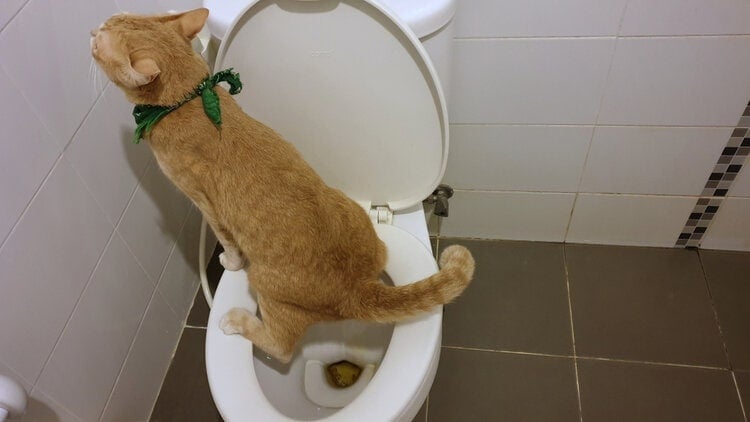Never Flush Cat Poop Down Your Toilet - Safeguard Your Pipes Infrastructure
Never Flush Cat Poop Down Your Toilet - Safeguard Your Pipes Infrastructure
Blog Article
The content which follows about Don’t flush cat feces down the toilet is unquestionably insightful. You should investigate for yourself.

Intro
As feline proprietors, it's essential to bear in mind how we take care of our feline close friends' waste. While it may appear practical to flush feline poop down the bathroom, this method can have detrimental consequences for both the setting and human health and wellness.
Environmental Impact
Purging cat poop introduces hazardous pathogens and bloodsuckers into the water supply, posing a substantial danger to marine ecological communities. These pollutants can adversely impact marine life and concession water quality.
Health and wellness Risks
Along with environmental concerns, flushing pet cat waste can also position wellness risks to people. Pet cat feces may consist of Toxoplasma gondii, a parasite that can trigger toxoplasmosis-- a possibly extreme illness, especially for expectant women and people with damaged immune systems.
Alternatives to Flushing
The good news is, there are much safer and extra accountable ways to take care of feline poop. Take into consideration the following options:
1. Scoop and Dispose in Trash
One of the most usual method of getting rid of feline poop is to scoop it right into a biodegradable bag and toss it in the garbage. Be sure to use a committed clutter scoop and get rid of the waste without delay.
2. Use Biodegradable Litter
Choose naturally degradable pet cat litter made from products such as corn or wheat. These clutters are eco-friendly and can be safely gotten rid of in the garbage.
3. Hide in the Yard
If you have a backyard, consider burying feline waste in a marked area away from veggie yards and water resources. Make certain to dig deep enough to prevent contamination of groundwater.
4. Install a Pet Waste Disposal System
Purchase a pet waste disposal system particularly designed for feline waste. These systems use enzymes to break down the waste, minimizing smell and environmental impact.
Verdict
Liable pet possession extends beyond offering food and shelter-- it likewise involves proper waste management. By avoiding flushing cat poop down the commode and going with alternative disposal methods, we can lessen our ecological footprint and safeguard human wellness.
Why Can’t I Flush Cat Poop?
It Spreads a Parasite
Cats are frequently infected with a parasite called toxoplasma gondii. The parasite causes an infection called toxoplasmosis. It is usually harmless to cats. The parasite only uses cat poop as a host for its eggs. Otherwise, the cat’s immune system usually keeps the infection at low enough levels to maintain its own health. But it does not stop the develop of eggs. These eggs are tiny and surprisingly tough. They may survive for a year before they begin to grow. But that’s the problem.
Our wastewater system is not designed to deal with toxoplasmosis eggs. Instead, most eggs will flush from your toilet into sewers and wastewater management plants. After the sewage is treated for many other harmful things in it, it is typically released into local rivers, lakes, or oceans. Here, the toxoplasmosis eggs can find new hosts, including starfish, crabs, otters, and many other wildlife. For many, this is a significant risk to their health. Toxoplasmosis can also end up infecting water sources that are important for agriculture, which means our deer, pigs, and sheep can get infected too.
Is There Risk to Humans?
There can be a risk to human life from flushing cat poop down the toilet. If you do so, the parasites from your cat’s poop can end up in shellfish, game animals, or livestock. If this meat is then served raw or undercooked, the people who eat it can get sick.
In fact, according to the CDC, 40 million people in the United States are infected with toxoplasma gondii. They get it from exposure to infected seafood, or from some kind of cat poop contamination, like drinking from a stream that is contaminated or touching anything that has come into contact with cat poop. That includes just cleaning a cat litter box.
Most people who get infected with these parasites will not develop any symptoms. However, for pregnant women or for those with compromised immune systems, the parasite can cause severe health problems.
How to Handle Cat Poop
The best way to handle cat poop is actually to clean the box more often. The eggs that the parasite sheds will not become active until one to five days after the cat poops. That means that if you clean daily, you’re much less likely to come into direct contact with infectious eggs.
That said, always dispose of cat poop in the garbage and not down the toilet. Wash your hands before and after you clean the litter box, and bring the bag of poop right outside to your garbage bins.
https://trenchlesssolutionsusa.com/why-cant-i-flush-cat-poop/

Hopefully you liked our part on How to Dispose of Cat Poop and Litter Without Plastic Bags. Thanks a lot for taking the time to read our blog post. Are you aware of somebody who is interested in the niche? Please feel free to share it. Thanks so much for taking the time to read it.
Book A Service Report this page